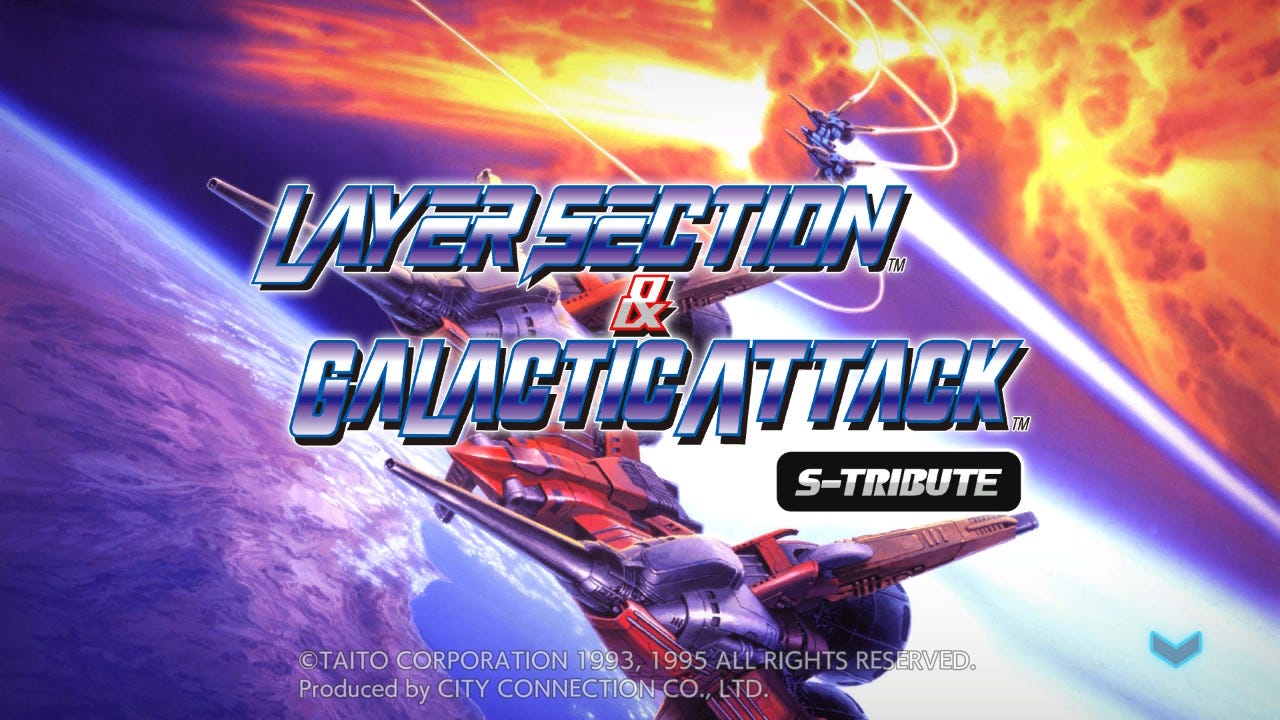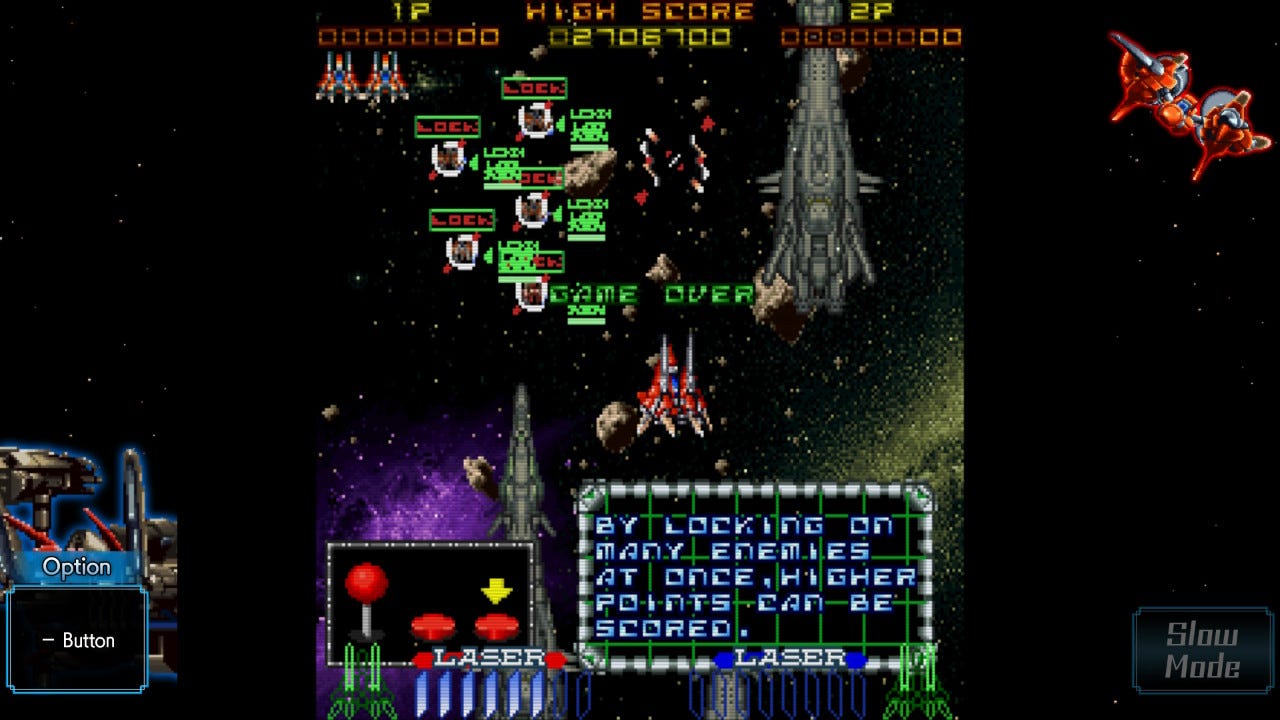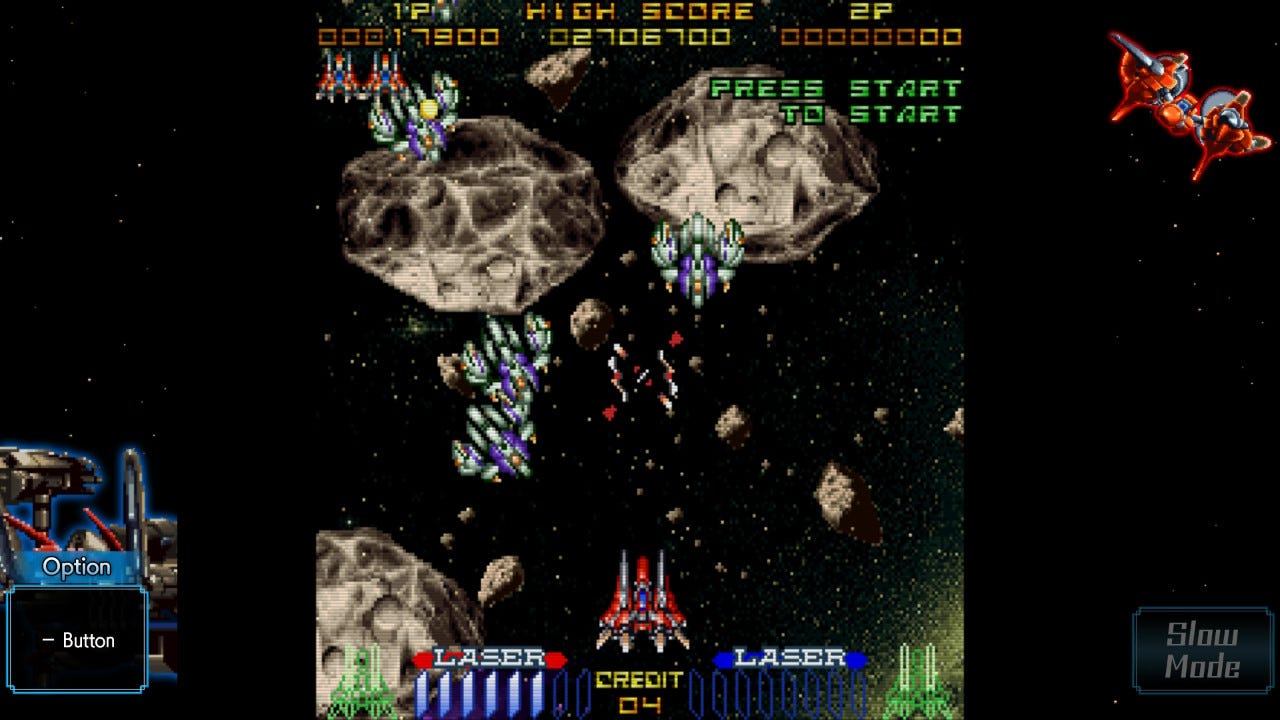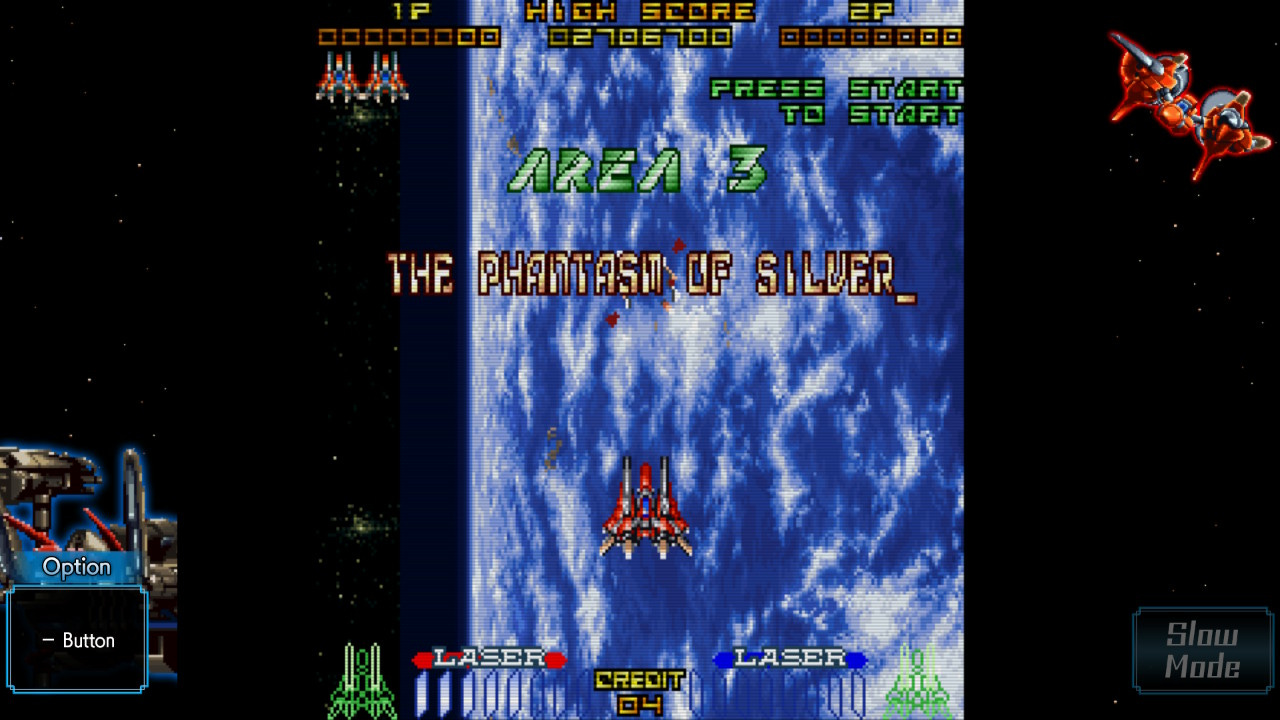Past meets present: Layer Section & Galactic Attack
A true classic shoot-em-up received a long overdue modern release, that gets by mostly on the substantial power of what was always there.
This column is “Past meets present,” the aim of which is to look back at game franchises and games that are in the news and topical again thanks to a sequel, a remaster, a re-release, and so on. Previous entries in this series can be found through this link.
Layer Selection, Galactic Attack, whatever you want to call it, might as well be a new game to most people. It’s a port, sure, but consider the game’s history. It was originally a 1994 arcade game called RayForce, developed by Taito’s Kumagaya branch for the company’s 32-bit Cybercore arcade hardware. While it received an international release, it was still an arcade game in the 90s, and a shoot-em-up, to boot, at a time when the rise of the fighting game had started to push shmups out of that particular spotlight.
It would receive a port to the Sega Saturn in 1995, and that was a problem if the idea was that anyone would get to play it. The Saturn sold around 9.3 million units worldwide throughout its entire life, and Layer Section/Galactic Attack released pretty early in said life, with the Japanese release coming in September of ‘95 and North America’s in December of the same year. The followup games ended up on the Playstation, too (or instead of, in the case of RayCrisis), for a reason.
Another couple of things that probably didn’t help were the fact that it had four names, and that critics were not enamored by it — more on the second part later. It was called RayForce in arcades, but trademark issues led to the home release having a different name: in Japan, Taito renamed the game Layer Section, which was the game’s working title in the design documents, but in North America and Europe, where Acclaim of all companies published it, the home release was the extremely generic “Galactic Attack.” I can’t tell you why, either: just two of the seven stages even take place in space, and the focus is far smaller in scope than “galactic” implies, too. The fourth name, by the way, was for the European arcade release of RayForce, where it was known as Gunlock — that was actually the runner-up title for the original game.
There isn’t much of a history of re-releases going on here, either, so you’ve mostly had to want to know it exists in order to discover it. Sure, there have been iOS and Android ports, if you’re into that sort of thing, but as for actual console or Windows re-releases? Next to nothing. The Xbox and PC versions of the excellent Taito Legends 2 collection had RayForce on it, but Playstation 2 users were out of luck for that particular game due to licensing problems. If you weren’t lucky enough to buy one of those games while they were available, well, you had better know a thing or two about emulation or modding or playing burned Saturn games if you didn’t want to spend $60-100 or so on the secondary market to experience a game that has mostly disappeared since its release.
That has all changed now, however, as we are in the midst of Taito’s various franchises and old-school goodies being given a second chance in the present. There is the Egret II Mini arcade cabinet releasing in 2022, of course, as well as the Taito Milestones collection, but there are also some individual releases getting attention: Liquid Kids as part of the Arcade Archive series, Taito’s and Natsume’s Pocky & Rocky getting a revival, the various Darius collections that have been trickling out for the past few years, and now, a port of Layer Section and Galactic Attack, with some modern additions.
Layer Section & Galatic Attack S-Tribute released basically everywhere on April 27, 2022. It’s on the Nintendo Switch, the Playstation 4, Xbox One, and Steam, and those middle two have backwards-compatible successor systems, too, those with a PS5 or Series X|S can have at it as well. It has basically never been easier to play this game before, and nearly 30 years after the arcade original’s initial release, well, you should. It’s a true classic and one of Taito’s finer shmup efforts, regardless of how it was critically received at the time — and now it’s in position to be more well-regarded in a present where the concerns pretty specific to 1995 aren’t there to bring it down.
The game was called “Layer Section” in its design document because of the way it plays: you are fighting off enemies that are on the same plane as your ship with your forward guns, but you also have a targeting laser cannon that fires in the “layer” below your ship. It’s vital that you do this, too, for a number of reasons. For one, targeting ships below your own with this laser allows you to achieve a much higher score than if you just waited for all of the ships to be on the same “layer” that your ship is on, as there are multipliers in play when you manage to target and destroy multiple foes with one burst — you can target four enemies at a time with the default version of the laser, and up to eight targets at once once you’ve picked up enough power ups.
And second, it’s because if you don’t target those ships and tanks and gun embankments below you, you will die. Simple as that! You basically need to do crowd control in the layer below in order to be able to effectively control the crowd at your own level, and if you can’t or won’t do that, you will die. Often. You’re basically fighting off two waves at the same time, utilizing two different firing buttons to do so, and the ships within all move faster and with more return fire as the game goes on. The screen is relatively cramped even at the start of things, and that’s intentional for this very reason: letting it fill with enemies is bad news you can prevent, if only you utilize the laser targeting, and often.
Take out specific waves of incoming fighters before they ever approach you. Blow up the larger carriers that are releasing these fighters in the first place. Weaken or outright destroy the giant mech craft carrying massive laser rifles before they can take up a significant part of the screen’s real estate before they even fire a shot at you. Blow away the tanks and guns taking aim at you from below, hoping to catch you unaware as a shot rips through the clouds and into your hull, before they can even fire. Find weak joints holding up platforms that carry tanks and guns and doors to the factories full of weapons below, and send them hurtling back toward the earth where they can’t antagonize you any further. All you have to do is move your ship’s targeting reticule into position over a target or targets, and then fire.
At its most basic level, this is an extension of the kind of gameplay that was found in the genre-defining Xevious in the prior decade. That’s not giving RayForce et al enough credit, though: this is the peak of that particular subgenre of shoot-em-up, a far busier, far more dangerous, and far more involved iteration of what Namco introduced to the world in 1982. Xevious had a slow pace, but Layer Section & Galactic Attack is fast. Xevious had a tiny ship and tiny enemies and tiny bullets. These games have a large ship and even larger foes on purpose: you have to focus on what’s in front of you and what’s below you, incessantly taking aim at both, all while dodging and weaving to avoid both collisions and having any of your enemies’ shots find your ship.
Mentioning all of that is probably a good time to bring up the critical reviews of the Saturn port.* Sega Saturn Magazine’s review said that the game is “severely outdated in terms of both graphics and gameplay”. Maximum’s review was even harsher, saying that sure, Galactic Attack is fun, but, “Come on - be honest now - is this really the sort of game you coughed up £300 to play with your high-tech next generation gaming system? Playable it may be, but it's not really worth buying.”
*Just want to make a note here that I searched for scans of the actual magazine reviews so I could link to them or pull out more of the quotes within, but alas, I had no such luck, so these are just the Wikipedia citations.
The implication of that last one, of course, is Galactic Attack is the kind of game that, if it weren’t a fit for the expensive shiny new gaming machine, should have been on previous generation hardware. Which is absurd for multiple reasons, like the fact that arcade hardware was ahead of what consoles were doing at the time RayForce originally released in arcades on Taito’s 32-bit board in 1994, which was already two years old by the time this particular game came out for it. It also shows a gross misunderstanding of just what Taito utilized the 32-bit hardware for, and why the Saturn port was able to be so close to the original arcade version in the first place.
If you play the game or watch any footage of it, you’ll notice it’s full of highly detailed sprites, an absurd number of craft on screen at once and all moving quickly while firing, and doing a far better job of making Mode 7-style graphics and animations look smooth and natural than the SNES was capable of. Even the Genesis, the predecessor to the Saturn which was much better-suited for fast-paced shmups than its chief competitor, couldn’t have managed what Galactic Attack was doing. Maybe the extra hardware didn’t go toward polygons, but in order to produce a sprite-based game that would look and play like this, well, a 16-bit system wasn’t going to be enough. So yes, if you were a shmup fan, then Galactic Attack is exactly what you spent your £300 or $300 on a Saturn for, because you weren’t about to grab a cabinet with RayForce on it out of the local arcade and put it in your house, were you?
Seriously, just look at this video, and try to tell me that it was ever going to happen on 16-bit hardware. The constant and rapid firing of the forward gun without any kind of graphical flickering occurring, while aiming the targeting laser at parts of the enemy’s ship that are actually on a different “layer” than what you’re firing at in front of you, while the background zips by at a speed that would have caused any of the 16-bit systems to either melt or explode after seizing up if they were even capable of having this programmed into them.
And this smoothness isn’t because the footage comes from the Switch port, either: this is based on the Saturn version of the game, after all, and I can tell you from firsthand experience that this is what the original Galactic Attack played like, too. I’m still impressed by it all in 2022, and yet, 1995 was unenthused. Their loss, really: the game has 3D elements to create the titular layers, it has excellent sprite work, it utilized the horsepower of both Taito’s 32-bit board and the Saturn’s own 32-bit hardware to load up on bullets and enemies coming at you from two different planes without an iota of slowdown, and for some reason, that didn’t seem very next-gen to some critics.
In fact, I’d go as far as to say that, visually, it holds up better than some of its competition at the time, like Namco’s NebulasRay. Like with 1994’s Donkey Kong Country on the SNES, pre-rendered computer graphics were at the heart of the game’s presentation, and the look of it all was certainly impressive at the time. Like with DKC, though, it hasn’t aged nearly as well on a visual scale as some of its sprite-based contemporaries, and the pre-rendered graphics don’t look as great on the backgrounds, or as in sync with their surroundings, as those of Layer Section & Galactic Attack. Neither is bad, mind you, it’s just worth noting how these perceptions can change over time: a fantastic refinement and bolstering of the present way of doing things vs. the newer, shinier approach went to the latter back in the day, but today, it’s the former that holds up best.
There are no breaks in between the stages of this game. No interstitial screens showing the points you just scored or how many bonus points you accrued or could have picked up. You simply defeat a boss, and then there is a brief moment of silence as the next piece of music loads up, and the name of the next stage appears, like so:
It all gives the game quite the cinematic feel, especially when you consider how tightly woven the game’s story and the way the stages are presented plays out. As you enter Area 3, for instance, you don’t just get a little cutscene of your ship zooming off into the distance, entering Earth’s atmosphere, and then appearing at the actual start of this third stage on Earth’s surface. Instead, you never lose control of your ship from the moment the boss fight of Area 2 ends and the announcement of Area 3 begins, and you will physically control it as it enters Earth’s atmosphere. The ship is even surrounded by the fireball of reentry until it has fully reached Earth, and the action portion of the stage begins with enemy ships coming up from below the clouds to “greet” you. It’s not as cinematic as what you can do today, sure, but it’s damned impressive for the time, and still lovely to see in action.
The game’s story, by the way, focuses on a single pilot sent to Earth to reclaim it from a rogue supercomputer. This AI system was designed to protect Earth’s systems and environments, but it eventually determined that the best way to do so was to destroy all of those things and replace them with mechanically constructed upgrades. Earth has been hollowed out, its insides replaced with a planet-sized factory fortress, and your goal is to descend to the core and blow the whole thing to hell. Sure, Earth will be just a little blown up and nonexistent as a result, but humanity — and all of its life, really — have already lost the planet to the machines. This will keep those machines from killing all of the non-mechanical life that exists in the solar system on colonies that have thus far escaped destruction. So this is why you begin in space, navigating an asteroid field and constructed defenses, and make your way both to and inside of Earth the rest of the way.
This release is called “Layer Section & Galactic Attack” but what that mostly means is that you have the Japanese and international releases of the game in one package. This isn’t one of those shmups with major, major differences between those versions — there are more than a few shoot-em-ups from the early 90s that swap stages around or completely remove them or add new bosses or make significant balancing choices to difficulty, so it can happen, just not here. This game is the game, probably in part because it was so fine-tuned to begin with, and the stage layout so intentional to the narrative. It’s a bit odd that RayForce isn’t also included in this just to get them all together in one place, especially since this game (these games?) didn’t have a universal release the last time Taito was making a big deal out of their back catalog in the aughts, but so it goes. You will buy much worse shmups than this classic for $30, even if it’s “incomplete” in the sense you really just have the one version here.
It’s worth noting the soundtrack for Layer Section & Galactic Attack. Unlike with some shmup re-releases, like 2021’s Raiden IV x Mikado remix, there is no rearranged version of things, or any new tracks, but you didn’t really need any of that here, either. Taito’s house band, Zuntata, absolutely nailed RayForce the first time for arcades, and since the Saturn was CD-based, the port’s soundtrack was able to replicate the original. It’s some of Zuntata’s and composer Tamayo Kawamoto’s greatest work, which is saying something. You can find the whole thing on YouTube, Spotify, Apple Music, wherever, and I suggest you should, but here’s “G,” which begins with the electronic instrumentation and transitional sound from Area 1 to Area 2 after the boss fight, then segues into vocals and the introduction of more and more instruments and sounds. It’s tremendous:
Even beyond the soundtrack stuff, if you’re a shoot-em-up fan who mostly buys some newer games or spends their time perusing what Arcade Archives has to offer, you should be pretty satisfied with both the emulation here as well as the modern additions and tweaks that publisher City Connection has brought to Layer Section & Galactic Attack S-Tribute. There is a Quick Save/Load feature, and rewinding that utilizes some loadable checkpoints instead of actually rewinding — it can be annoying, to not have a frame-by-frame option, but you’ll make it work if you want to utilize it. (Note, though, that messing around with all of this does impact which online rankings your playthrough is eligible for.)
It’s also a positive that the screen-sizing options here have expanded a bit beyond what was in the original home release, which already had a TATE mode (listed as “Arcade”) though, good luck making that work if your CRT was not a small one: I never bothered to flip around my 28-inch Toshiba to check it out. Now you can flip things into TATE as well as enlarge the game, which still looks excellent even when you don’t use the smaller resolution — that’s certainly not always the case with older games, but the scanlines and anti-aliasing options do a good job of cleaning things up even zoomed in a bit. And it’s all welcome given the intentionally cramped nature of the presentation, too.
There are also button remapping options, which I immediately ran to in order to make the B button for firing targeted lasers and the Y button for my front guns, so that I could always hold down the latter and press down on the former as needed. (It also allows you to find a button to even implement the Slow Mode, should you be using an Arcade Stick — the default Slow Mode button is clicking the right analog stick, which you don’t have on an arcade stick.) Maybe most welcome is the ability to play with 4, 8, or 99 credits: Layer Section/Galactic Attack is not an easy game, and it’s worth your time to play it with 99 credits until you’ve got a real feel for it and have learned it. Then you can start to challenge yourself. Along the same lines, the Slow Mode is useful, especially in later stages if you want to try to utilize it like you’re playing DoDonPachi and you’ve got a bullet-time thing going on. I played in Slow Mode for a bit to have time to re-learn enemy attack patterns, then the next time I played, did so at normal speed, and did a much better job of things.
If that’s not enough, you can also adjust how intense the game’s Rank system is. Rank, for the uninitiated, is basically a shmup’s counterweight to your success. The longer you stay alive and succeed, the harder the game is going to try to kill you. If you don’t want that kind of rubberbanding effect present, you can tweak it, or you can crank it up from the start.
If you’re used to Arcade Archives, this will all sound like a lot of modern niceties, but if you’re familiar with the M2 ShotTriggers series, you’re going to think this is kind of a bare minimum setup that’s well above simply re-releasing the game again for $30, but behind where it could be. I don’t know if this game needed that series’ Gadgets in the letterboxing to help demystify certain game elements, but hey, M2 made those useful even for relatively simple games like Aleste, so maybe there was something to do here. In the end, it’s still a port that made Layer Section/Galactic Attack available again decades after its first and only non-phone release, so… net positive. It is, after all, one of the greats, and one not nearly enough people have experienced yet, but should.
This newsletter is free for anyone to read, but if you’d like to support my ability to continue writing, you can become a Patreon supporter.






